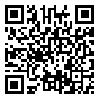Sat, Jul 19, 2025
[Archive]
Volume 7, Issue 2 (June 2011)
IJEEE 2011, 7(2): 70-83 |
Back to browse issues page
Download citation:
BibTeX | RIS | EndNote | Medlars | ProCite | Reference Manager | RefWorks
Send citation to:



BibTeX | RIS | EndNote | Medlars | ProCite | Reference Manager | RefWorks
Send citation to:
Homaeinezhad M R, Tavakkoli E, Afshar A, Atyabi A, Ghaffari A. Neuro-ANFIS Architecture for ECG Rhythm-Type Recognition Using Different QRS Geometrical-based Features. IJEEE 2011; 7 (2) :70-83
URL: http://ijeee.iust.ac.ir/article-1-328-en.html
URL: http://ijeee.iust.ac.ir/article-1-328-en.html
Abstract: (12414 Views)
The paper addresses a new QRS complex geometrical feature extraction technique as well as its application for electrocardiogram (ECG) supervised hybrid (fusion) beat-type classification. To this end, after detection and delineation of the major events of ECG signal via a robust algorithm, each QRS region and also its corresponding discrete wavelet transform (DWT) are supposed as virtual images and each of them is divided into eight polar sectors. Then, the curve length of each excerpted segment is calculated and is used as the element of the feature space. To increase the robustness of the proposed classification algorithm versus noise, artifacts and arrhythmic outliers, a fusion structure consisting of three Multi Layer Perceptron-Back Propagation (MLP-BP) neural networks with different topologies and one Adaptive Network Fuzzy Inference System (ANFIS) were designed and implemented. To show the merit of the new proposed algorithm, it was applied to all MIT-BIH Arrhythmia Database records and the discrimination power of the classifier in isolation of different beat types of each record was assessed and as the result, the average accuracy value Acc=98.27% was obtained. Also, the proposed method was applied to 8 number of arrhythmias (Normal, LBBB, RBBB, PVC, APB, VE, PB, VF) belonging to 19 number of the aforementioned database and the average value of Acc=98.08% was achieved. To evaluate performance quality of the new proposed hybrid learning machine, the obtained results were compared with similar peer-reviewed studies in this area.
Keywords: Feature Extraction , Curve Length Method , Multi Layer Perceptron , Adaptive Network Fuzzy Inference System , Fusion (Hybrid) Classification , Arrhythmia Classification , Supervised Learning Machine
Type of Study: Research Paper |
Subject:
Biomedical Signal Processing
Received: 2010/09/27 | Revised: 2011/12/24 | Accepted: 2013/12/30
Received: 2010/09/27 | Revised: 2011/12/24 | Accepted: 2013/12/30
| Rights and permissions | |
 |
This work is licensed under a Creative Commons Attribution-NonCommercial 4.0 International License. |







